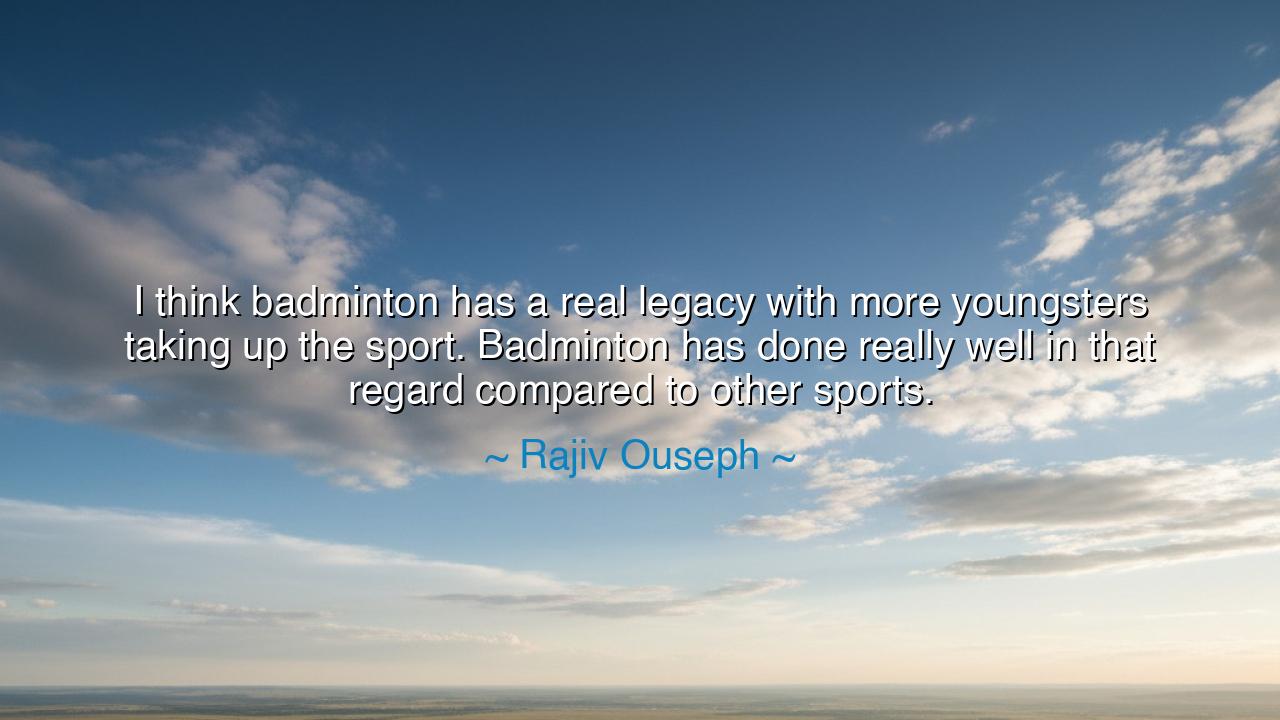
I think badminton has a real legacy with more youngsters taking
I think badminton has a real legacy with more youngsters taking up the sport. Badminton has done really well in that regard compared to other sports.






When Rajiv Ouseph declared, “I think badminton has a real legacy with more youngsters taking up the sport. Badminton has done really well in that regard compared to other sports,” his words carried not only praise for a game, but also recognition of a flame passed from one generation to the next. This is the essence of legacy—that which outlives the moment and becomes a guiding fire for those who come after.
The ancients too spoke of legacy, not only in kings and empires, but in the practices and disciplines that bound communities together. A sport is not merely a contest of shuttle and racket—it is a school of patience, of agility, of discipline, and of joy. When Ouseph honors badminton’s legacy, he celebrates its ability to shape youth into resilient beings, just as the old training grounds of Greece shaped boys into warriors and philosophers alike.
There is a great power in youngsters taking up the sport. For every child who grasps the racket is not merely learning to strike a shuttle; they are entering into a living tradition. In ancient China, the bow was not simply a weapon but a ritual of character. To draw it taught steadiness, humility, and control. Likewise, badminton teaches the heart to endure rallies, to rise again after each lost point, and to respect the rival across the net. These lessons endure far beyond the court.
History itself offers a clear example: the revival of the Olympic Games in the late 19th century. They were born from a dream to give youth across nations not just competition, but character, shared identity, and brotherhood. The games created a legacy that still endures, binding generations through sport. In the same way, badminton, though humbler and quieter in its reach, has sown seeds in the lives of countless children, reminding us that greatness is not always loud—it often grows in silence until it fills the world with its presence.
When Ouseph compares badminton’s success “to other sports,” he is pointing to the remarkable ability of this game to survive in the shadow of more dominant spectacles. Football, cricket, basketball—they roar like thunder. Badminton, by contrast, is often quieter, like a whisper in the wind. Yet, this whisper has reached far, inspiring youth, building communities, and creating champions who rise from small halls and school courts to global arenas. This is the strength of legacy: not noise, but endurance.
What, then, shall we take as a lesson? That each of us must honor the legacies we inherit, whether in sport, in craft, or in culture. To dismiss them is to sever ourselves from the roots that nourish us. To continue them is to water the tree so that future generations may find shade. If you are young, take up a practice that strengthens you not only in body but in spirit. If you are older, guide the young by example, for the torch must always pass from hand to hand.
Practically, this means encouraging youth to pursue not only the games of glory, but also those that teach humility, balance, and perseverance. Support the smaller fields, the lesser-known arts, the quieter disciplines—for in them lies hidden greatness. Play, guide, mentor, and honor the courts where laughter, discipline, and respect take root.
Thus, Ouseph’s words remind us that true legacy is not measured in noise or medals alone, but in the number of lives touched, shaped, and uplifted. Badminton has indeed done well, and so may every craft or calling that dares to pass its flame forward. Let us honor these legacies, and let us become legacies ourselves—so that when we are gone, our gifts too may echo in the laughter and striving of those yet to come.






AAdministratorAdministrator
Welcome, honored guests. Please leave a comment, we will respond soon